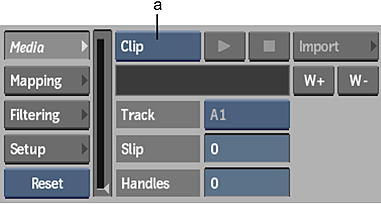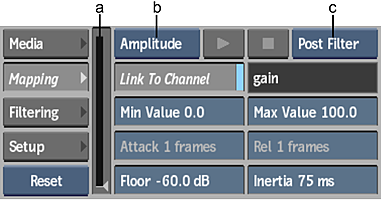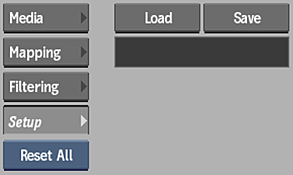Audio Keyframe Settings
The animation controls Audio tab has a number of submenus with numerous settings to help you work with your audio clips.
Common Settings
There are a few common settings found in the Audio submenus.
Play
Plays the audio media.
Stop
Stops the audio playback.
Reset option
Select whether to reset the current Audio submenu, or all of the Audio settings.
Available in the Media, Mapping, and Filtering submenus. In the Setup submenu, only Reset All is available.
Media Submenu

(a) Media Source
Media Source option
Select whether to analyse the current audio clip (audio attached to the front, back, or matte clips, for example), or the imported audio file.
Import
Opens the import audio browser to load a file.
Clip Name option
If multiple audio clips are available, select which clip to use as source media. If only one audio clip is available, the name of the clip appears in a locked field.
W+
Displays the selected media's waveform in the Animation editor.
W-
Hides the waveform.
Channel option
Select which audio channel to use as source media.
Slip field
Displays the amount of frames to slip the media.
Handles field
Displays the amount of handles (frames) to analyse before and after the current shot duration.
For example, with a shot of 100 frames, if you enter 30 in this field, the total number of frames becomes 160 (30 frames before and 30 frames after the original 100 frames).
Mapping Submenu

(a) Audio Level Indicator (b) Tracking Mode (c) Listening Mode
Tracking Mode option
Select whether to use an Amplitude or Transient tracking mode.
In Amplitude tracking mode, a keyframe is generated at each frame, following the envelope of the audio signal. In Transient tracking mode, a keyframe is generated for each audio transient (sudden rise in amplitude), provided that the signal rises above the specified threshold.
Listening Mode option
Choose between Pre Filter (audio as it was imported) and Post Filter (audio with any changes made) monitoring when playing back audio media. Does not affect the analysis.
Link to Channel
Enable to map the tracked audio to the selected animation channel. An 'a' appears in the channel list next to the name of the linked channel. Multiple channels can be selected simultaneously.
Channel Name field
This locked field displays the name of the selected channel being linked to the tracked audio. Multiple Channels is displayed if more than one channel is selected.
Min Value field
Displays the minimum value at which keyframes can be set in the linked channel.
Max Value field
Displays the maximum values at which keyframes can be set in the linked channel.
Attack field
Displays the number of frames needed for the channel to reach the Max Value before a transient. Available only in Transient tracking mode.
Release field
Displays the number of frames needed for the channel to reach the Min Value after a transient. Available only in Transient tracking mode.
Threshold field
Displays the value at which a keyframe is generated each time the signal rises above it. Available only in Transient tracking mode.
Floor field
Displays the minimum level of the audio media to be considered for the analysis (typically used to remove analysis noise between audio transients). Available only in Amplitude tracking mode.
Inertia field
Displays the rate at which the signal decreases after a transient.
In Transient tracking mode, the Release field can be increased to avoid the generation of several consecutive keyframes when the transient is not clearly defined in the input signal. Conversely, if the Release field is set to 0 ms, each transient rising above the threshold generates a keyframe, even if each occurs within a few milliseconds of another.
Audio Level Indicator
A visual representation of the audio level and the current Threshold or Floor value.
Reset option
Select Reset to reset the Mapping submenu settings only. Select Reset All to reset all of the Audio settings.
Filtering Submenu

(a) Audio Level Indicator (b) Tracking Mode (c) Frequency Graph (d) Listening Mode
Frequency Graph
A visual frequency representation of the audio signal being tracked. The audio display is always Pre Filter.
Frequency Range Preset option
Select a frequency range preset to determine the cutoff frequencies for Low and High filters.
Low field
Displays the lowest frequency of the input signal used in the analysis (also represented by a triangle under the frequency graph). Use the slider or field to adjust.
High field
Displays the highest frequency of the input signal used in the analysis (also represented by a triangle under the frequency graph). Use the slider or field to adjust.
Setup Submenu

Load
Click to load a saved audio mapping setup.
Save
Click to save an audio mapping setup.
Setup Name field
This locked field displays the name of the loaded setup
